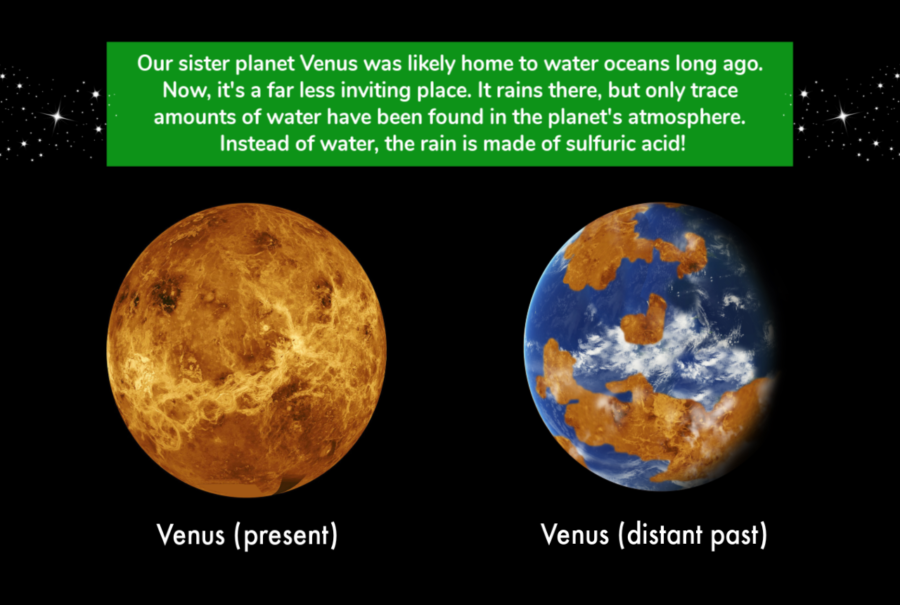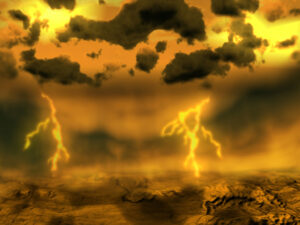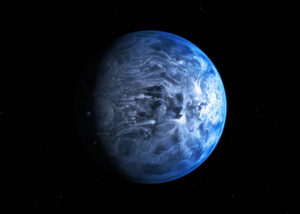Happy Umbrella Day (yes, that’s a thing)!

Umbrellas typically hold up just fine to normal Earth conditions, but if you took them to some of the wilder planets in space, a standard umbrella wouldn’t exactly do the job. From the diamond drizzle on Neptune to the showers of molten lava on an exoplanet, our Milky Way galaxy is home to some extreme weather! Read on to get a taste of it from the comfort and safety of your home.
Venusian Deluges
Rain is soothing to many people, but it certainly wouldn’t be calming if you were on Venus! Sometimes called our sister planet, Venus is similar to Earth in many ways. Its mass, size, and surface gravity are all pretty close to Earth’s. Venus may have even been home to watery oceans long ago, but there’s no water on the surface today (and only tiny amounts in its atmosphere). Venus’s atmosphere is packed with carbon dioxide—a powerful greenhouse gas—and that has made all the difference!

The thick Venusian atmosphere locks in heat from the Sun so well that it’s hot enough to melt lead at the surface (which has actually happened to landers we sent there—they were also crushed because the pressure is so extreme.) Water has no chance at all on Venus’s surface! But rain doesn’t have to be made of water, and indeed in many places in the cosmos, it isn’t.
The predominantly carbon dioxide atmosphere on Venus is tinged yellow because of sulfur. This sulfur comes in the form of sulfuric acid, which condenses (goes from gas to liquid form) higher up in the atmosphere where temperatures are colder. It then rains this poisonous sulfuric acid—but none of it ever makes it to the surface.

That’s because it gets hotter and hotter on the way down, to the point that it re-evaporates before hitting the ground! So Venus has this bizarre, toxic sulfuric acid version of the more familiar water cycle suspended in midair. Scientists have even discovered that these hellish showers aren’t all Venusian weather has to offer—there’s lightning, too!
Diamond Drizzles on Uranus and Neptune
In sharp contrast to the Venusian deluges, Uranus and Neptune feature drizzles of solid diamonds. These icy worlds are the seventh and eighth planets in the solar system, about 1.8 and 2.8 billion miles away from the Sun, respectively. It will probably come as no surprise that they are very different from the warmer, rocky inner planets.
Raining diamonds, though—sounds like a fairytale, right? According to researchers at the SLAC National Accelerator Laboratory in Menlo Park, California, here’s how it works: We know that both Uranus and Neptune have small amounts of methane and ammonia in their atmospheres. The two react in the extreme pressure and temperature conditions present beneath the icy planets’ surfaces (gravity crushes stuff there together so tightly that it becomes very hot).
The result? According to laboratory simulations—diamonds! Since the diamonds would be denser than their icy surroundings, they would sink further down. Remember how Venus had an acid rain cycle suspended in midair? On Uranus and Neptune, the diamond rain would occur completely beneath the planets’ surfaces.

Rain of Terror on Exoplanet HD 189733b
In a whole new kind of nightmare, this strange planet, dubbed HD 189733b, doesn’t merely rain shards of glass, it’s also so windy that the glass-rain slices through the planet’s sky sideways. The planet orbits a relatively nearby Sun-like star, a little over 60 light-years away from Earth. Despite its Earth-like blue appearance, HD 189733b is actually a “hot Jupiter”—a giant, Jupiter-sized planet that orbits extremely close to its star.
Earth looks blue because of light reflected from our oceans, but NASA explains that this exotic exoplanet looks blue because of a hazy, blow-torched atmosphere containing high clouds laced with silicate particles. And these are no calm skies—the clouds whip around the planet at seven times the speed of sound! With its mega-hurricane winds and rain of glass, HD 189733b is not a place you would want to travel to.
Molten Iron Rain on Rogue Planet
It doesn’t sound so crazy for a planet to have rusty dust—just look at Mars! But on the exoplanet dubbed PSO J318.5-22, you’d need quite a heavy-duty umbrella to deal with some of the effects of that pesky dust. It’s home to fiery rains of molten iron!
Even with the ultimate rain gear, you’d struggle to exist on this planet’s surface, since its temperature is around 1500 degrees Fahrenheit. Is that because it’s so close to its star? Nope! PSO J318.5-22 doesn’t orbit a star at all.
It’s one of an unknown number of mysterious rogue planets in our galaxy. Scientists aren’t sure how rogue planets form, though they may have been somehow ejected from star systems. However they form, they retain some of the heat from their formation, until they eventually succumb to the profound cold of open space. -By Ashley Balzer Vigil. Vigil is a volunteer at the Lake Afton Public Observatory in Goddard, Kansas. She works as a science writer at NASA’s Goddard Space Flight Center in Greenbelt, Maryland.
